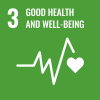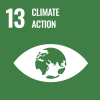Belet Weyne, 8 August 2023 – Zamzam knows the devastation of climate shocks all too well. First, drought pushed her to move away from the place she had called home for years, then flooding swept away the new home she’d just begun to build for herself and her family.
Living through the relentless drought in Somalia, Zamzam, a 60-year-old grandmother, embarked on a challenging journey. Together with her three grandchildren, she set out in search of food, water, and humanitarian assistance. Compelled to leave their village due to a lack of resources, they ultimately found refuge in a displacement site in the central Somali city of Belet Weyne, some 300 kilometres away from their home.
Over the past two years, Belet Weyne has been impacted by a dual crisis that has tested the resilience of its residents. Since 2021, the community has grappled with acute water scarcity as Somalia endures its longest and most devastating drought in recent history, after five consecutive below-average rainy seasons.

Zamzam and her grandchildren sit inside their makeshift shelter in a displacement site in Belet Weyne, Somalia. Photo: IOM
Across the country, the resulting widespread displacement forced more than 1.3 million people from their homes. The drought also caused a devastating food and water crisis, pushing over 7 million people – almost half of the country's population – to the brink of starvation.
The prompt response and increased support from the government, aid organizations, and international partners alleviated people’s most pressing needs and prevented imminent famine in some areas of the country. However, just as people began to recover, another crisis struck the region.
The arrival of the Gu rainy season, typically spanning from April to June, did not bring the anticipated relief expected by the communities in Belet Weyne and numerous other regions in southern and central Somalia. Instead, the heavy rains triggered the most destructive floods the country has witnessed in decades, wreaking havoc on the lives of over 468,000 people and displacing nearly 419,000 individuals.

Aerial view of Belet Weyne in May 2023, a town in central Hirshabelle State, Somalia, greatly affected by the floods. Photo: IOM
These floods not only compounded the hardships faced by those still struggling with the drought but also rendered recovery nearly impossible for those who had already lost everything.
"While the rains provided some relief to drought-stricken areas, the situation remains dire. The heavy rains have exacerbated the vulnerabilities of the population, that have not had time to recover between shocks," said Frantz Celestin, IOM Chief of Mission.
Prior to the onset of floods, IOM had launched a coordinated response in partnership with UNICEF, the World Food Programme (WFP) and local partners, known as the minimum response package (MRP). This initiative aimed at saving lives and supporting newly displaced individuals affected by the drought. The package included first-line essential relief items such as water, hygiene kits, cash assistance, shelter materials, and nutrition supplements.

The floods in Belet Weyne, Somalia, rendered roads impassable, submerged bridges, disrupted movement, and isolated communities. Photo: IOM
"We received mats, plastic sheets, jerry cans, and other vital items when we settled in the displacement site. These supplies were incredibly helpful,” expressed Zamzam, who was one of the thousands who benefited from the aid package. “We used the plastic sheets to cover our shelter and the jerry cans to store water.”
Between January and March 2023, IOM and its partners assisted nearly 200,000 people in Belet Weyne, Banadir and Baidoa through the MRP.
Zamzam also received financial support via her mobile phone. For two months, she utilized this cash to acquire essential food items like rice, flour, sugar, and cooking oil, ensuring her grandchildren had daily meals. She also allocated some funds towards settling her debts.

Aerial view of a dry Dawa river in Doolow. The floods are the latest in a series of extreme weather events to hit Somalia. Since early 2021, the country has also been experiencing one of its worst droughts in recent history, which rapidly dried up water sources and rivers. Photo: IOM
However, just as Zamzam and her children were beginning to rebuild their lives, the floods ravaged the town.
"One night we were peacefully sleeping and suddenly we woke up to a powerful rain rushing through our shelters. It was late at night, and we felt powerless.”
In the midst of chaos, she managed to salvage only a few belongings, including a mat, a plastic sheet, and some jerry cans. One of her grandchildren even came close to losing his life.
“One of my grandchildren was swept away by the floods, but fortunately, people managed to rescue him.”
Once again, the family found themselves facing profound loss and sought shelter on higher ground outside the city, away from the flood-affected areas.
“Not even a few weeks after we had distributed relief items to those affected by the drought, people found themselves in the midst of another catastrophe. Our teams swiftly scaled up support, and we started to organize the distribution of supplies across the country,” said IOM’s Celestin.

IOM staff registers families affected by the floods for the distribution of relief items. Photo: IOM
IOM teams have been assisting flood-affected individuals and collecting data on displacement and cross-border mobility to inform the response efforts. So far, IOM has coordinated the rapid deployment of aid to 8,000 families in Baardheere and Belet Weyne, two of the most flood-affected cities. The assistance provided included hygiene kits, water trucking, emergency shelter materials, and health and sanitation services.
Zamzam and her family were among those who received this new vital support.
In addition, IOM has started to roll out regular hygiene promotion and awareness campaigns to mitigate the risk of waterborne diseases. Teams have also started the rehabilitation of existing water sources to ensure displaced families like Zamzam's have access to safe drinking water during this crisis.

Newly displaced individuals receive plastic tarps to improve the condition of their makeshift shelters after being impacted by floods in Belet Weyne, Somalia. Photo: IOM
Zamzam and her grandchildren now sit on the mat she managed to salvage, showing their resilience and determination to keep going in the face of repeated climate events.
Thanks to generous funding from the United Kingdom Government, the United States, the European Union, Japan, and CERF.
For more information, please reach out to IOM Somalia Communications Team: smsom-media@iom.int
Written by Claudia Rosel and Muthoni Njenga / IOM Somalia.


